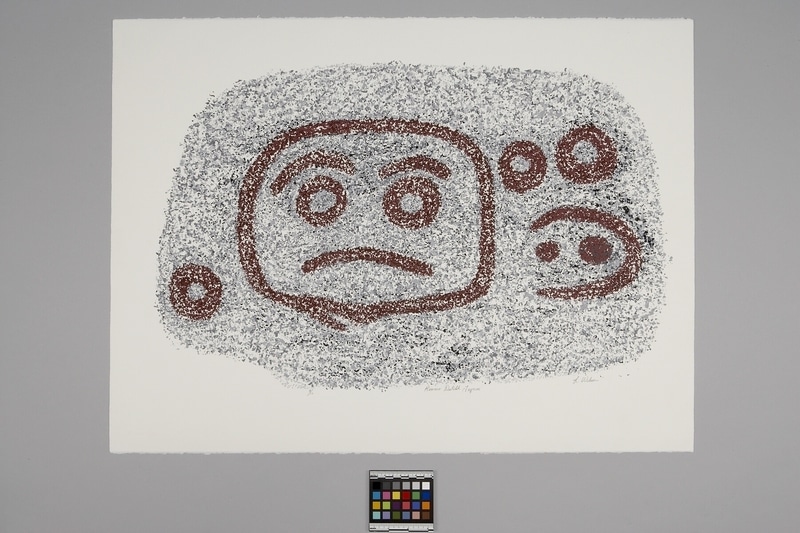Kemano Dulith Teyxva Item Number: Nb3.1389 from the MOA: University of British Columbia

Description
Oval image formed of three shades of grey and black amorphous dots. Circles and a simple face are outlined in two shades of red-brown amorphous dots. Central face has an ovoid head, round eyes, eyebrows, and a downward turned band for the mouth. Small circle at left of chin, two at right of temple, and a sideways horseshoe shape below with two circles inside. Written inscription across bottom reads '7/10 Kemano Dutilh Teyxva L. Wilson'. The print is on horizontally rectangular, deckle edged white paper stock. Reverse watermark letters on back bottom right read 'BFK Rives France' with an infinite symbol.
History Of Use
Northwest Coast serigraphs are a contemporary art form, deriving from early 20th century drawings of traditional crest and decorative designs, commissioned by anthropologists and undertaken by artists such as Charles Edenshaw. Residential schools reinforced the medium, while discouraging the use of traditional themes. An important series of traditional designs in coloured pencil and watercolour were done by Mungo Martin for UBC in 1949-50. The 1960's saw the rapid growth of prints, first in unlimited poster editions, and later with the establishment of the Gitanmaax School of Northwest Coast Indian Art at 'Ksan (1967), and of the Northwest Coast Indian Artists Guild (1977), limited edition art runs became the standard. Northwest Coast silkscreen prints are part of the mainstream art market, as well as, functioning within the native context as potlatch gifts, and commemorative prints. Although, there are distinctive regional styles, individual artists may work in several styles, or apply unique themes and variations to specific works.
Narrative
The petroglyph is accredited to Billy Hall of the Fish Clan. He picked the images to commemorate a sighting of Buxwus (Wild Man of the Woods).
Cultural Context
contemporary art
Item History
- Made by Lyle Wilson (Maker) in Kitamaat, British Columbia, Canada on June 30, 1987
- Owned by Lyle Wilson before August 7, 1987
- Received from Museum of Anthropology Shop Volunteers (Funding source) and Lyle Wilson (Seller) on August 7, 1987
What
- Name
- Kemano Dulith Teyxva
- Identification Number
- Nb3.1389
- Type of Item
- Manufacturing Technique
- silkscreened
- Overall
- height 57.1 cm, width 76.3 cm, depth 0.1 cm
Who
- Culture
- Haisla
- Creator
- Lyle Wilson (Maker)
- Previous Owner
- Lyle Wilson
- Received from
- Museum of Anthropology Shop Volunteers (Funding source) and Lyle Wilson (Seller)
Where
- Holding Institution
- MOA: University of British Columbia
- Made in
- Kitamaat, British Columbia, Canada
When
- Creation Date
- on June 30, 1987
- Ownership Date
- before August 7, 1987
- Acquisition Date
- on August 7, 1987
Other
- Item Classes
- works on paper
- Condition
- good
- Accession Number
- 1226/0001